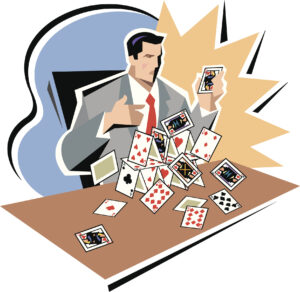Financial Weapons of Mass Destruction: The Global House of Cards Casino
The comments below are an edited and abridged synopsis of an article by Herland Report
On March 10, Silicon Valley Bank (SVB) collapsed and was taken over by regulators. SVB was the 16th-largest bank in the US and its bankruptcy was the second largest in US history.
Despite its size, SVB was not a “systemically important financial institution” (SIFI) as defined in the Dodd-Frank Act, which requires insolvent SIFIs to bail in the money of their creditors to recapitalize themselves.
Technically, the cut-off for SIFIs is $250 billion in assets. However, they are systemically important because their failure could bring down the whole financial system; pull out one card and the whole house collapses. SVB held $27.7 billion in derivatives, but that is only 0.05% of the $55,387 billion held by JPMorgan, the largest US derivatives bank.
SVB could be the canary in the coal mine foreshadowing the fate of other over-extended banks, but its collapse is not the sort of systemic risk predicted to trigger contagion.
That designation comes chiefly from banks’ exposure to derivatives, the global casino so interconnected that it is a house of cards.
This article focuses on derivatives and the bail-in provisions of the Dodd-Frank Act, which eliminated taxpayer bailouts by requiring insolvent SIFIs to recapitalize themselves with the funds of their creditors.
Creditors include depositors, but deposits under $250,000 are protected by FDIC insurance. However, the FDIC fund is sufficient to cover only about 2% of the $9.6 trillion in insured deposits. A nationwide crisis triggering bank runs across the US, as happened in the early 1930s, would wipe out the fund.
Today, some are predicting a crisis of that magnitude in the quadrillion-dollar-plus derivatives market, due to rapidly rising interest rates. Herland looks at how likely that is and what can be done either to prevent it or dodge it.
Up for discussion: Financial weapons of mass destruction; risks hidden in the shadows; the perverse incentives created by ‘safe harbor’ in bankruptcy; the interest rate shock; and alternative solutions.

